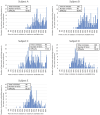Identification of parameters for electronic distance examinations
- PMID: 38962711
- PMCID: PMC11220322
- DOI: 10.3389/fvets.2024.1385681
Identification of parameters for electronic distance examinations
Abstract
Introduction: This study investigates the log data and response behavior from invigilated in-person electronic timed exams at the University of Veterinary Medicine Hannover, Foundation, Germany. The primary focus is on understanding how various factors influence the time needed per exam item, including item format, item difficulty, item discrimination and character count. The aim was to use these results to derive recommendations for designing timed online distance examinations, an examination format that has become increasingly important in recent years.
Methods: Data from 216,625 log entries of five electronic exams, taken by a total of 1,241 veterinary medicine students in 2021 and 2022, were analyzed. Various statistical methods were employed to assess the correlations between the recorded parameters.
Results: The analysis revealed that different item formats require varying amounts of time. For instance, image-based question formats and Kprim necessitated more than 60 s per item, whereas one-best-answer multiple-choice questions (MCQs) and individual Key Feature items were effectively completed in less than 60 s. Furthermore, there was a positive correlation between character count and response time, suggesting that longer items require more time. A negative correlation could be verified for the parameters "difficulty" and "discrimination index" towards response time, indicating that more challenging items and those that are less able to differentiate between high- and low-performing students take longer to answer.
Conclusion: The findings highlight the need for careful consideration of the ratio of item formats when defining time limits for exams. Regarding exam design, the literature mentions that time pressure is a critical factor, since it can negatively impact students' exam performance and some students, such as those with disabilities, are particularly disadvantaged. Therefore, this study emphasizes finding the right time limits to provide sufficient time for answering questions and reducing time pressure. In the context of unsupervised online exams, the findings of this study support previous recommendations that implementation of a stringent time limit might be a useful strategy to reduce cheating.
Keywords: E-assessment; examinations; item formats; log data; open-book; response time; veterinary education.
Copyright © 2024 Richter, Tipold and Schaper.
Conflict of interest statement
The authors declare that the research was conducted in the absence of any commercial or financial relationships that could be construed as a potential conflict of interest. The author(s) declared that they were an editorial board member of Frontiers, at the time of submission. This had no impact on the peer review process and the final decision.
Figures






Similar articles
-
Measures for Quality Assurance of Electronic Examinations in a Veterinary Medical Curriculum.J Vet Med Educ. 2024 Dec;51(6):762-776. doi: 10.3138/jvme-2023-0061. Epub 2023 Nov 28. J Vet Med Educ. 2024. PMID: 39504174
-
Use of key feature questions in summative assessment of veterinary medicine students.Ir Vet J. 2013 Mar 7;66(1):3. doi: 10.1186/2046-0481-66-3. Ir Vet J. 2013. PMID: 23497425 Free PMC article.
-
[Evaluation of examination preparation methods in veterinary students].Tierarztl Prax Ausg K Kleintiere Heimtiere. 2020 Feb;48(1):15-25. doi: 10.1055/a-1091-1981. Epub 2020 Feb 14. Tierarztl Prax Ausg K Kleintiere Heimtiere. 2020. PMID: 32059249 German.
-
Impact of summer programmes on the outcomes of disadvantaged or 'at risk' young people: A systematic review.Campbell Syst Rev. 2024 Jun 13;20(2):e1406. doi: 10.1002/cl2.1406. eCollection 2024 Jun. Campbell Syst Rev. 2024. PMID: 38873396 Free PMC article. Review.
-
The Advantages and Challenges of Electronic Exams: A Qualitative Research based on Shannon Entropy Technique.J Adv Med Educ Prof. 2025 Jan 1;13(1):1-11. doi: 10.30476/jamp.2024.102951.1987. eCollection 2025 Jan. J Adv Med Educ Prof. 2025. PMID: 39906078 Free PMC article. Review.
References
-
- Marinoni G, Vant Land H, Jensen T. The impact of Covid-19 on higher education around the world. IAU Global Survey Rep. (2020) 23:1–17.
-
- Seyfeli F, Elsner L, Wannemacher K. Vom Corona-Shutdown Zur Blended University?: Expertinnenbefragung Digitales Sommersemester. 1st ed. Baden-Baden, Germany: Tectum; (2020).
-
- Wissing F. Digitale Lehre für alle: Voraussetzungen, Machbarkeit und Optionen im Human- und Zahnmedizinstudium. Medizinischer Fakultätentag. (2020). Available at: https://medizinische-fakultaeten.de/wp-content/uploads/2020/10/MFT-und-G...
-
- Gnewuch L. Digitalisierung der Lehre– Situationsanalyse und Perspektiven in der Veterinärmedizin. [Dissertation]. Berlin, Germany: Freie Universität Berlin; (2023).
LinkOut - more resources
Full Text Sources

